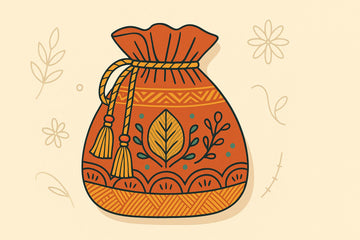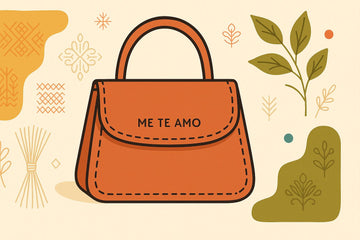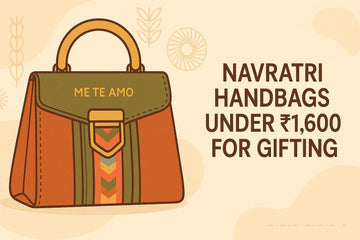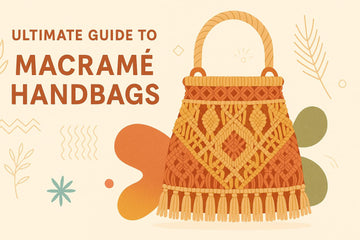Potli Bags: From Royal Courts to Modern Fashion
by Medhansh Malhotra on Jul 07, 2025

Potli bags have a long history, evolving from simple pouches in ancient India to luxurious accessories during the Mughal era. Once symbols of royalty, they were crafted with rich materials like silk and velvet, adorned with embroidery and precious stones. Today, potli bags combine classic designs with modern materials like jacquard cotton, vegan leather, and recycled fabrics. They’re affordable, functional, and available online, appealing to a wide audience. Beyond fashion, they support artisan communities, making them stylish and socially impactful accessories. These bags continue to bridge India's heritage with modern fashion trends.
1. Historical Potli Bags
Materials and Craftsmanship
The journey of potli bags through history is a testament to the skill and creativity of Indian artisans. In ancient Vedic times, these pouches were made from practical materials like cotton and jute, chosen for their durability and suitability for daily use. They were used to carry coins, herbs, and other small essentials during travel, blending functionality with simplicity.
A major shift came during the Mughal era (1526–1857), when these humble pouches transformed into luxurious accessories. Artisans began using rich fabrics such as silk and velvet, embellishing them with intricate zardozi embroidery - a technique involving gold thread to create elaborate patterns. To enhance their elegance, craftspeople adorned the bags with pearls, beads, and even precious stones, turning them into symbols of wealth and sophistication.
The Rajput era brought another layer of artistry to potli bags. Designs were tailored to match traditional attire, with colours and patterns carefully chosen to complement the wearer's outfit. This era not only elevated the aesthetic appeal of potli bags but also deepened their cultural and symbolic significance.
Design and Symbolism
Over time, potli bags evolved into more than just practical items - they became cultural artefacts rich with meaning. In Indian traditions, these bags symbolised prosperity and good fortune. They were often filled with grains or precious stones and gifted during auspicious occasions as a gesture of blessing and goodwill.
As the designs grew more intricate, with detailed embroidery and embellishments, potli bags took on a deeper narrative role. Mythological references in ancient texts like the Ramayana and the Mahabharata mention characters such as Lakshman and Arjuna using similar pouches during their journeys. These stories imbued potli bags with qualities like preparedness and wisdom, elevating them from simple accessories to meaningful symbols.
Functionality and Accessibility
The practicality of potli bags was a key factor in their popularity. The drawstring closure made them easy to use while ensuring the contents stayed secure - an essential feature for travellers and merchants alike. This blend of utility and elegance made them a staple for various purposes across different eras.
In Ayurvedic practices, potli bags found a unique role. They were used to store medicinal herbs and even prepare therapeutic poultices, showcasing their functional versatility. What’s more, these bags were accessible to all social classes. While the wealthy flaunted silk and velvet versions adorned with intricate decorations, simpler cotton and jute versions served the same purpose for everyday folk.
Social and Cultural Impact
Potli bags were more than just accessories - they were reflections of social status and cultural identity. During the Mughal period, the quality and craftsmanship of a potli bag often indicated its owner's position in society. Nobles carried bags made from the finest materials, decorated with elaborate designs, as a visible marker of their wealth and influence.
These bags also held a special place in traditional celebrations. Festivals and weddings often featured potli bags as part of gift-giving rituals, used to present money, jewellery, or other treasured items. Over time, they became woven into Indian storytelling, appearing in folk tales and religious narratives that celebrated virtues like generosity, wisdom, and preparedness. This enduring cultural presence has ensured that potli bags remain a cherished part of Indian heritage across generations.
2. Modern Potli Bags (e.g., Me Te Amo)

Materials and Craftsmanship
Modern potli bags have taken a fascinating turn, blending time-honoured techniques with eco-friendly materials to cater to today’s conscious consumers. While traditional potlis were crafted from rich silks and velvets reminiscent of royal courts, modern versions embrace materials like jacquard cotton blends, raffia, hand-loom cotton, vegan leather trims, and recycled polyester linings. These choices reflect a shift towards sustainability without compromising on elegance.
Take Me Te Amo, for example. Their potli bags are handcrafted by skilled women artisans, ensuring that each piece is a testament to authentic Indian craftsmanship. By employing low-waste cutting techniques and reviving traditional weaving methods, brands like these are preserving age-old skills while meeting the demands of modern sensibilities.
The emphasis on craftsmanship has also evolved. Historical potlis were primarily decorative, but today’s designs strike a balance between beauty and practicality. Durable construction and cruelty-free materials speak to the changing values of consumers who want luxury that aligns with ethical practices. This thoughtful approach to materials and design paves the way for fresh interpretations of a classic accessory.
Design and Symbolism
Modern potli bags are not just about aesthetics - they’re steeped in meaning. They continue to symbolise prosperity and good fortune, but in today’s context, they also represent a connection to Indian heritage in a globalised world. Designs now blend traditional motifs with contemporary styles, making them versatile enough for both ethnic and Western outfits.
These bags have embraced bold colours, geometric patterns, and minimalist aesthetics, appealing to women who want their accessories to make a statement. Beyond their visual appeal, modern potlis also reflect values like sustainability, women’s empowerment, and pride in Indian craftsmanship. They’ve become more than just fashion items - they are expressions of identity and values.
The design evolution caters to modern lifestyles too. While historical potlis were reserved for ceremonial use, today’s versions are versatile enough for daily wear, weddings, and festive occasions. This adaptability has made them a favourite among urban women who appreciate accessories that effortlessly transition across different settings.
Functionality and Accessibility
Functionality has taken centre stage in the modern potli’s reinvention. Today’s designs feature secure closures, inner pockets, and reinforced linings, making them practical for carrying daily essentials. Lightweight materials and adjustable straps add to their convenience, ensuring they remain as functional as they are stylish.
Accessibility has also seen a major boost. Me Te Amo’s pricing strategy, which ranges between ₹699 and ₹2,499 after permanent markdowns, ensures that these handcrafted accessories are available to a wider audience. The pricing strikes a perfect balance - affordable enough for impulse buys yet premium in quality and feel.
The rise of online distribution has further expanded their reach. Brands now cater to customers across Tier-1 and Tier-2 cities, offering convenient payment options like COD, UPI, and digital wallets. With pan-India delivery partnerships, these once regional treasures have become accessible to fashion enthusiasts nationwide.
Social and Cultural Impact
Modern potli bags are more than just stylish accessories - they’re catalysts for social change. By focusing on women-led craftsmanship, brands like Me Te Amo are not only preserving traditional skills but also creating sustainable livelihoods for artisans. These bags have become a medium for cultural storytelling, connecting generations through design and craftsmanship.
Urban women aged 18–34 have embraced these bags for their ability to blend style with cultural significance. They’re drawn to accessories that reflect their heritage while aligning with modern values like ethical consumption and sustainability.
From their origins as royal accessories to their current status as everyday fashion staples, potli bags have undergone a remarkable transformation. They’re now a bridge between tradition and modernity, appearing not just at weddings and festivals but also in daily life. By merging cultural roots with contemporary appeal, modern potli bags continue to make their mark on both fashion and society.
KASHEE`S BRIDAL | POUCH MAKING
sbb-itb-be0b177
Pros and Cons
The journey of potli bags from royal opulence to everyday charm offers a fascinating mix of benefits and challenges, reflecting the shifts in design, purpose, and accessibility across eras. Let’s take a closer look at how these elegant accessories have transformed over time.
Historically, potli bags were crafted with rich materials like silk and velvet, adorned with intricate embroidery and precious embellishments. These luxurious designs were symbols of royalty and grandeur, reserved for the elite and used mainly during ceremonial occasions. However, their exclusivity and ornate nature limited their practicality - they were more about status than function.
In contrast, modern potli bags are all about blending tradition with functionality. They are made using sustainable materials like jacquard cotton blends, handloom fabrics, vegan leather, and recycled polyester linings. Designed with features like secure closures and inner pockets, they’re not just stylish but also practical. With prices ranging from ₹699 to ₹2,499, they are far more accessible to a wider audience. This affordability, combined with online availability and payment options like COD and UPI, has made them a popular choice across India.
Modern designs cater to both traditional and contemporary tastes, making them suitable for a variety of occasions - whether it’s a wedding, festival, or even daily outings. Beyond fashion, these bags have a deeper social impact. Many brands employ women artisans, reviving traditional weaving techniques and creating sustainable livelihoods. This has turned modern potli bags into symbols of empowerment and a celebration of heritage.
Here’s a quick comparison of historical and modern potli bags:
| Aspect | Historical Potli Bags | Modern Potli Bags |
|---|---|---|
| Materials | Silk, velvet, gold/silver threads, pearls, precious stones | Jacquard cotton blends, handloom fabrics, vegan leather, recycled polyester |
| Craftsmanship | Intricate, hand-embroidered, unique designs | Handcrafted with a focus on sustainability and modern aesthetics |
| Social Role | Status symbol for royalty and elites | Fashionable accessory supporting cultural revival and artisan empowerment |
| Accessibility | Exclusive to the wealthy | Widely available online with pan-India delivery |
| Price Range | Customised luxury items | ₹699–₹2,499 |
| Versatility | Primarily ceremonial | Suitable for daily wear, festivals, weddings, and modern outfits |
| Sustainability | Not a consideration | Eco-friendly and cruelty-free materials prioritised |
However, modern potli bags aren’t without their challenges. The push for affordability through mass production can sometimes compromise the artisanal quality that made historical pieces so unique. Additionally, the use of synthetic materials in some cases may affect durability and detract from their cultural significance.
Despite these challenges, modern potli bags have managed to bridge the gap between tradition and modernity. They celebrate Indian craftsmanship while adapting to today’s needs, ensuring that these timeless accessories remain relevant and meaningful. By evolving from exclusive royal treasures to inclusive fashion staples, potli bags continue to honour their heritage while embracing the demands of contemporary lifestyles.
Conclusion
Potli bags have journeyed from being symbols of royalty to becoming stylish, functional accessories that honour tradition while embracing modernity. They effortlessly blend cultural heritage with contemporary design, showcasing how age-old craftsmanship can thrive in today’s fashion landscape.
Modern consumers are increasingly drawn to sustainability and ethical production, and this shift is reflected in the evolution of potli bags. Many brands now craft these bags using eco-friendly materials and fair production practices, keeping the traditional essence alive while meeting current demands. The rise of customisation has further allowed people to add a personal touch, blending their unique style with timeless traditions.
Brands like Me Te Amo highlight this beautiful synergy. Their handcrafted potli bags, made with jacquard cotton blends and recycled polyester linings, not only preserve traditional weaving techniques but also support local artisans and communities. By choosing such women-led, sustainable brands, we contribute to a legacy that connects India’s rich past with its dynamic future.
Potli bags continue to charm across generations, whether paired with ethnic attire for weddings and festivals or styled with modern outfits for everyday elegance. Their ability to seamlessly fit into diverse settings ensures they remain an enduring accessory.
As we look ahead, potli bags stand as a powerful example of how tradition can evolve without losing its essence. They prove that heritage and innovation can coexist, creating a perfect balance between the old and the new, and keeping the spirit of craftsmanship alive for years to come.
FAQs
How have potli bags transformed from traditional utility items to modern fashion accessories?
Potli bags have journeyed far from their humble beginnings in ancient India, where they were simple cotton or jute pouches used to store essentials like herbs and spices. Over the centuries, they transformed into symbols of opulence and fine craftsmanship. In royal courts, potli bags were crafted from rich fabrics like silk, velvet, and brocade, adorned with intricate embroidery, shimmering zari work, and even semi-precious stones.
Today, potli bags strike a harmonious balance between traditional artistry and modern aesthetics. Contemporary designs showcase luxurious materials like silk and velvet, beautifully embellished with sequins, beads, and mirror work. These elegant accessories have become a must-have in ethnic fashion, effortlessly elevating festive and wedding outfits while honouring their rich cultural legacy.
How do modern potli bags support artisan communities and promote sustainable fashion?
Modern potli bags hold a special place in preserving traditional craftsmanship and uplifting artisan communities. These bags are meticulously handcrafted by skilled artisans, many of whom are women, using materials like organic cotton, jute, and recycled fabrics. By opting for these materials, potli bags not only minimise environmental impact but also honour India's rich heritage of artistry.
Beyond their aesthetic appeal, these bags are a step towards ethical fashion. They support fair production practices and provide artisans with meaningful economic opportunities. Each handcrafted potli bag represents a choice that sustains local art forms, empowers communities, and promotes eco-conscious living.
How have potli bags evolved from traditional Indian craftsmanship to modern fashion accessories?
Potli bags have transformed over time, merging traditional Indian artistry with a modern twist. Once gracing the royal courts as a mark of luxury, these bags now showcase detailed embroidery, beadwork, and handcrafted techniques that pay homage to India’s rich heritage.
In recent years, designers have given potli bags a fresh spin by incorporating materials like vegan leather, bold fabrics, and metallic touches. This blend of old-world charm and contemporary style makes them perfect for festive celebrations as well as casual outings. These reimagined potli bags not only reflect India’s cultural roots but also align with today’s evolving fashion trends.




